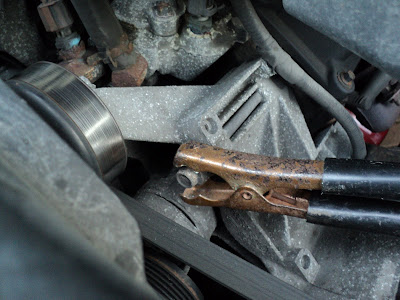Jump-starting carries with it two risks that one must be mindful of. They're easily eliminated.
Short-Circuit Risk
If inadvertently short-circuited, a charged lead-acid battery will deliver a massive amount of electrical energy to the short-circuit. The consequences of that can be nasty. Make connections one polarity at a time -- i.e. positive-to-positive; negative-to-negative. Never connect a cable set to a booster battery with both the other cable ends left unconnected.
Explosion Risk
The risk is small, but it's not zero. It's greater with unsealed batteries (the type with screw-off caps on the cells for adding water).
A characteristic of lead-acid batteries is that while charging, the cells can emit hydrogen and oxygen that results from electrolysis of water. Needless to say, one doesn't want to introduce sparks to such a gas mixture. Adhering to the correct cable connection sequence and method pretty much eliminates the risk.
Cable Connection Sequence
1) Positive connection at dead battery.
2) Positive connection at booster battery.
3) Negative connection at booster battery.
4) Negative connection at dead vehicle.
It's that fourth connection that's fraught with peril. Some sparking is very likely to occur as the connection is made. That's actually normal, and not a cause for concern. Ideally, though, the connection should be made not at the dead battery, but at a good, clean ground point on the engine/chassis/body. On some vehicles, a good ground connection point is easy to come by. Here's an example.
 That idler pulley bracket on my 3.0 litre Ford Ranger is a good place.
That idler pulley bracket on my 3.0 litre Ford Ranger is a good place.Some vehicles can be remarkably difficult to find a good ground connection point in aside from the battery terminal itself. A very good way to deal with that is to install a purpose-made, dedicated jump-starting ground terminal. I'll put one in the Ranger to demonstrate.
The Ranger's front bulkhead has a nicely positioned 1/2" hole in it already, just below where the hood rod is attached. I took the Dremel grinder to its perimeter and got down to bright, naked steel all around it, like this.
 Should you have to create a hole for the purpose, use a chassis punch. A 1/2" twist drill applied to sheet metal will give rough, nasty results.
Should you have to create a hole for the purpose, use a chassis punch. A 1/2" twist drill applied to sheet metal will give rough, nasty results.A 1/2" x 1 1/2" bolt, two nuts and three washers will make a fine terminal.
 Use only new, oxide-free parts. Lubricate everything with WD-40, install and tighten for all you're worth. Here's how it looks when done.
Use only new, oxide-free parts. Lubricate everything with WD-40, install and tighten for all you're worth. Here's how it looks when done. And now, when your battery dies in the beer store's parking lot in the rain in the dark, you won't have to search for a good, clean, safe ground terminal to make your fourth connection to. One will be right there ready.
And now, when your battery dies in the beer store's parking lot in the rain in the dark, you won't have to search for a good, clean, safe ground terminal to make your fourth connection to. One will be right there ready. Give the terminal a shot of WD-40 whenever you have the hood open, and you'll always have a clean connection point for a boost.
Give the terminal a shot of WD-40 whenever you have the hood open, and you'll always have a clean connection point for a boost.- - -
One last point about connecting cables -- don't be gentle about it. Connection points are likely to be oxide-coated. Gently clamping onto them will be ineffective; an oxidized battery terminal may as well be wrapped with electrical tape -- oxides are that good an insulator. As you apply each clamp, rock it so it can bite through the oxide.
# # #
# # #
No comments:
Post a Comment